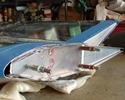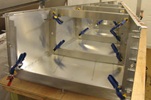


random user submitted photo
Solenoid squeaking noise
13 posts
• Page 2 of 2 • 1, 2
Re: Solenoid squeaking noise
I agree that you should wire the alternator through the NO terminal. As far as what is loading the cap, it may be the sense leads on the shunt. I would not be concerned about a battery failure bringing down your alternator. If it dies in flight, it is unlikely to be a short and the alternator will keep the relay pulled in. If it dies on the ground you won't/shouldn't be flying anyway.
Bryan Cotton
Poplar Grove, IL C77
Waiex 191 N191YX
Taildragger, Aerovee, acro ailerons
dual sticks with sport trainer controls
Prebuilt spars and machined angle kit
Year 2 flying and approaching 200 hours December 23
Poplar Grove, IL C77
Waiex 191 N191YX
Taildragger, Aerovee, acro ailerons
dual sticks with sport trainer controls
Prebuilt spars and machined angle kit
Year 2 flying and approaching 200 hours December 23
-

Bryan Cotton - Posts: 5090
- Joined: Mon Jul 01, 2013 9:54 pm
- Location: C77
Re: Solenoid squeaking noise
gammaxy wrote:Here's a shot in the dark:
- Master switch open, alternator switch closed
I believe this would correspond to Master Off, Alternator Off with the way you originally wired the alternator relay.- Master switch closed, alternator switch closed (Master on, alternator off)
Capacitor begins charging until alternator relay switches to N.O. position.- Master switch open, alternator switch closed (Master off, alternator off)
Alternator relay switches back to N.C. position. Now the capacitor has a discharge path to ground through the relay coil and alternator switch. The relay opens and closes multiple times as the capacitor discharges to the point it can no longer open the relay.
Wiring the alternator relay to the N.O. position should prevent this scenario as once the circuit opens, there will be no path for the capacitor to discharge through the coil.
If this is the case, then it wasn't the capacitor making the noise, but a strange relay sound caused by it partially actuating multiple times. I can't think of any other scenarios for the capacitor making a noise without involving a short circuit or arcing inside the capacitor, but without the regulator, starter motor, 20A fuse, this is the only explanation that comes to mind, strange as it seems.
Thanks Chris,
I showed my diagram to one of the electricians at work yesterday and that was exactly his analysis as well.
Michael
Sonex #145 from scratch (mostly)
Taildragger, 2.4L VW engine, AeroInjector, Prince 54x48 P-Tip
VH-MND, CofA issued 2nd of November 2015
First flight 7th of November 2015
Phase I Completed, 11th of February 2016
http://www.mykitlog.com/rizzz/
Sonex #145 from scratch (mostly)
Taildragger, 2.4L VW engine, AeroInjector, Prince 54x48 P-Tip
VH-MND, CofA issued 2nd of November 2015
First flight 7th of November 2015
Phase I Completed, 11th of February 2016
http://www.mykitlog.com/rizzz/
- rizzz
- Posts: 869
- Joined: Tue Jun 21, 2011 2:07 am
- Location: Wollongong, NSW, Australia
Re: Solenoid squeaking noise
sonex1374 wrote:Michael,
Let me offer a few suggestions.
Ammeter shunt placement: The ammeter can tell you different things depending on where it's located. You have it placed between teh power bus and battery. This will tell you how much current the power bus is drawing *out of the battery* at any given time. It won't tell you the total draw because the alternator is supplying power to the bus also, and that power doesn't go thru the shunt. Likewise, the starter doesn't go thru the shunt, so you won't see the true demand on the battery when starting. If this is what you want to monitor with the ammeter (the in-flight draw on the battery), then it's ok. If you want total draw by the power bus (from the battery and/or alternator combined), then you'll need to move the shunt. If you want total current flow into or out of the battery at any given time, you'll need to move the shunt.
Alternator Disconnect Relay: The way your diagram shows it, the alternator disconenct relay is always "closed" and the regulator output (alternator) is always tied into the power bus. In fact, once the engine is running, you could turn off the master switch (disconnecting the battery) and the regulator output would continue to keep the panel running. Activating the "Alternator Switch" would disconnect the regulator (alternator) and power would cease to flow into the power bus or battery contactor.
If you reverse the connection of the alternator relay from the "Normally Closed" terminal (what you have now) to the "Normally Open" terminal, the alternator will be disconnected (offline) until you activate the switch. The choice is yours, however, there are a few other considerations. If your regulator goes haywire, gets really hot, and tries to melt down in flight, you'll be able to keep the regulator from pumping in power to your bus by disconnecting the alternator relay, but you'll be unable to stop the regulator from continuing to melt down. This is because the alternator is *always* supplying the regulator with AC current, whether the regulator is connected to anything or not. Moving your alternator disconnect relay to the AC lines coming from the alternator (before the regulator) completely isolates the alternator from the regulator and not just the power bus. It's probably a remote chance or a regulator failure that melts itself down, but this method gives you a chance to stop it in it's tracks.
Squeeling Noise: The noise is possably due to the capacitor discharging into the system. Try disconnecting the capitor from the system and see if the noise goes away. If it does, then that's what making the squeel. One option is to place a small load across the capacitor that will slowly discharge it once the battery (or regulator) have stopped supplying power. I suggest a small resitor (1/4 watt, 10k ohm) or 12v lamp connected to the + and - leads. This will "drain" the capacitor without really affecting the rest of the system while in normal operation.
I hope this makes sense and helps.
Jeff Shultz
Thanks Jeff, this is very helpful information.
I'm new to this so I've designed my diagram based on the various other ones I found out there. Including your 604 diagram, thanks for sharing that one.
Regarding the ammeter shunt placement, I think it is where I want it. The ammeter is a +30A / -30A Ammeter from Falcon (http://www.aircraftspruce.com/catalog/i ... 30-001.php)
I want to measure current going into and out of the battery. As I understand it (from one of the conversations of the Vans forum) in this position the ammeter needle should be centered at 0 most of the time with short periods of current going to the battery after starting the engine. Prolonged periods of the needle indicating current into the battery could suggest a battery (charging) problem, likewise prolonged periods of current being drawn out of the battery would suggest my alternator/voltage regulator have a problem.
Regarding the starter current through the shunt, the instructions that come with the ammeter specifically say not to do this as the 200+ Amps drawn by the starter motor will well exceed the +/-30A range of the ammeter and will break it.
About putting the alternator relay before the voltage regulator, I have thought about this, I just haven't seen anybody do it this way so given my lack of knowledge in this area I thought I'd keep it safe stick with what others have done. All diagrams I can find online have it setup either with no alternator disconnection mechanism or with the relay positioned where I have it.
The squealing noise was indeed coming from the alternator relay, not the capacitor or master solenoid.
Using the N.O. pin and flipping the switch around fixed the issue.
Michael
Sonex #145 from scratch (mostly)
Taildragger, 2.4L VW engine, AeroInjector, Prince 54x48 P-Tip
VH-MND, CofA issued 2nd of November 2015
First flight 7th of November 2015
Phase I Completed, 11th of February 2016
http://www.mykitlog.com/rizzz/
Sonex #145 from scratch (mostly)
Taildragger, 2.4L VW engine, AeroInjector, Prince 54x48 P-Tip
VH-MND, CofA issued 2nd of November 2015
First flight 7th of November 2015
Phase I Completed, 11th of February 2016
http://www.mykitlog.com/rizzz/
- rizzz
- Posts: 869
- Joined: Tue Jun 21, 2011 2:07 am
- Location: Wollongong, NSW, Australia
13 posts
• Page 2 of 2 • 1, 2
Who is online
Users browsing this forum: No registered users and 4 guests







